WashPost: "NSA weighs its options"
After a near defeat in the House this week for the NSA “metadata” program, NSA and its supporters might want to wonder why so many Republicans voted against what they think is essential for national security. (Of course having “block monitors” as the former East Germany had and Cuba now has would also help national security.)
Today’s Washington Post had a column by David Ignatius that reviews possible compromises that both protect national security as well as restore the rule of law and order and respect the Bill of Rights.
The article states:
To NSA officials, this access to calling records is supremely valuable. The problem is that many Americans are uncomfortable with it, despite repeated NSA assurances that, under the program, only the calling data are collected, not the calls themselves. Public uneasiness was suggested by a Washington Post-ABC News poll this week showing that 74 percent of those surveyed believe NSA surveillance of telephone records intrudes on the privacy rights of some Americans.
So how could the NSA reassure the American public? The agency keeps the calling records in what’s described as an electronic “lockbox” that can only be accessed by a small number of people when there is a “reasonable, articulable suspicion” that numbers need to be checked.
It then goes on to give several alternatives, some similar to thoughts we have discussed previously.
Comments in Cellphone/Prison Rulemaking (Docket 13-111)

Carl Lackl, Jr. (l) a Baltimore witness murdered as a result of a prison cell phone call.
Capt. Robert Johnson (r) South Carolina Department of Corrections, shot 6 times
at his home as a result of a prison cell phone call.
Your blogger has filed comments in Docket 13-111, which deals with “Promoting Technological Solutions to Combat Contraband Wireless Device Use in Correctional Faciliteis (sic)”. These comments were on behalf of MSS, not for any previous or current client and were made solely in the public interest. At 34 pages without attachments they happen to be the longest filing to date, although length does not necessarily imply quality or success. So far, the docket file has 43 items from outside FCC, mostly comments
The comments start with the above photos of Carl Lackl, Jr. and Captain Robert Johnson to remind readers that unlike virtually all FCC proceedings, this one does not deal with just economic benefits for one party versus another, but rather an unintended side effect of today’s CMRS technology in which real people die.
The comments review the unusual history of this proceeding including multiple petitions that sat in “petition limbo” for years even though some were from local governments and even though Section 1.403 of the FCC’s own rules requires that such petitions be assigned a file number and “promptly “ be included on a public notice for comment. In particular, the MSS comments include as attachments parts of the 2010 GTL petition that have never been commented on that deal with mandates needed to make managed access effective in all cases and which give alternative theories that would permit the Commission the discretion to authorize jamming in special cases if it was found to be in the public interest. Cellular interests cling to an interpretation of Section 333 of the Communications Act that has never been endorsed by the FCC or a court that says FCC lacks jurisdiction to authorize jamming but NTIA has such jurisdiction for federal users.
MSS urges the Commission to require all CMRS carriers to provide the spectrum under reasonable terms needed for MAS if requested by a prison. While today’s major carriers do so and promise to pressure smaller carriers, the reality is no one knows what firms will be CMRS carriers in rural areas next year since many spectrum auctions are pending to implement the spectrum demands of cellular interests. MSS also urges the Commission to require mandatory a priori coordination of all technical changes to the cellular network near prisons with MAS systems in order to maintain the functioning of MAS throughout the network evolution.
The comments emphasize that cell phones in prisons is a complex issue and that no “magic bullet” is likely to be found that eliminates the whole problem without causing side effects. While cellular interests claim jamming would inevitably cause “overjamming” that impacts users outside prisons (see CTIA video) , their preferred “managed access systems”/MAS will also cause excess coverage in prisons that do not have an adequate buffer from publicly accessible areas, such as at Sing Sing Correctional Facility in New York.
The comments raise the issue of financing MAS or other costly solutions and points out the interrelationship between this issue and the ongoing WC Docket No. 12-375 which seeks to reduce the present high cost of inmate communication services (ICS). While cellular interests would like the state and local governments to shoulder the financial cost of exotic technology in the hostile environment of prisons, MSS points out that the carriers themselves are in a better position to handle the financial and technical burdens than prison administrators. Shifting the cost to ICS operators, as California is trying to do, may seem tempting but the inmates are truly a “captive audience” who have already been overcharged for years for telecom services. Increased contact with families can decrease recidivism -- whose costs to society and the economy dwarfs the sums involved in this issue.
The MSS comments also propose a new approach to handle contraband cell phones in prisons that deals with the special case of rural maximum security prisons - actually the location of most of the serious problems since dated suburban maximum security facilities like Sing Sing are rare now. The new approach is called “geolocation-based denial”/GBD and builds on the existing E-911 program. It is proposed that prison with a 300m buffer between secure areas and areas accessible to the general public be allowed to request the Commission to remove the secure area from the coverage of all CMRS carriers. The carriers
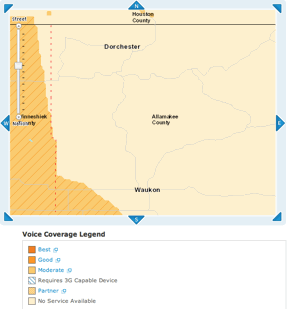
Reply comments are still open in this proceeding. vox populi, vox dei
Current ATT coverage in rural Iowa
UPDATE
FCC’s Australian counterpart, Australian Communications and Media Authority/ACMA, has a new blog entry on “Removing jammers from the streets”. Included is the above video. ACMA says
Targeting prohibited devices has demanded an agile approach to compliance. Our activities also include preventative (education/awareness) and enforcement measures. This has helped to restrict the supply of jammers to the local market, forcing consumers to turn to online sources for devices that are often seized before reaching their destination.
The Australian penalties for unauthorized jammer marketing and use are much greater than in the US. For example the blog says:
There could be more substantial penalties, such as receiving a five-year prison sentence or penalty of up to $850,000 (5,000 penalty units) for causing substantial interference to radiocommunications used by emergency services (such as fire, police and ambulance) and other special organisations. And these aren’t the only penalties that could apply.
Note from the video that ACMA, unlike the US cellular interests, is clearly able to differentiate between authorized controlled jamming in prisons and unauthorized jamming that endangers public safety. Compare this with the following CTIA video which vilified both prison jamming and unauthorized jamming based on alleged experience in Brazil.
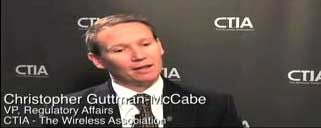
CTIA interview on prison jamming (June 2009)
UPDATE
Mr. Guttman-McCabe no longer works at CTIA and the interview on prison jamming discussed above has magically disappeared from the CTIA website. But there isn sign that CTIA's policy has changed at all.
Efficient Use of Government Spectrum Act of 2013: NTIA Will Regret Its Silence on AWS-3

CEA immediately praised the new bill with its president and CEO Gary Shapiro, saying:
“This legislation represents an important effort in reallocating our nation’s valuable spectrum for wireless broadband, while raising much-needed funds for the U.S. Treasury. The 1755-1780 MHz band represents key spectrum that our nation’s innovators need to deploy robust mobile broadband networks for the benefit of all Americans.”
Similarly Tim McKone, AT&T Executive Vice President of Federal Relations, said
“AT&T commends Congresswoman Matsui and Congressman Guthrie for introducing legislation that would free up spectrum that is critically important for the wireless industry. While AT&T continues to work with federal agencies and industry on potential spectrum sharing scenarios of government-held spectrum, the economic benefits of an exclusive licensing framework cannot be denied. The wireless industry has invested billions of dollars in infrastructure under this framework. Making the 1755 MHz to 1780 MHz spectrum available for commercial mobile broadband use will not only spur additional investment but will further help fund our nationwide public safety network.”
Oddly, T-Mo, the most obvious beneficiary of this action has been silent to date.
[Note even though AT&T and CEA are praising the new bill, the text is not yet available to mortals such as us. A visit to THOMAS, the Library of Congress website for “the rest of us” at the time of this writing returns the following message:
“The text of H.R.2739 has not yet been received from GPO “]
But this brings to mind NTIA’s silence curing the M2Z/AWS-3 struggle in which M2Z Networks, a former MSS client, sought to solve the idle status of the 2155-2180 MHz band by using it for time division duplex (TDD) operation and leave the federal users in the lower band alone. This proposal was vilified by the cellular industry in general, except for Sprint which was supportive of TDD, and was the subject of a 4.5 year FCC deliberation that was never resolved on either the technical or nontechnical issues pending. Indeed, it ended with a phone call from an FCC staffer to M2Z’s main investor that said though even though over 4 years had elapsed FCC couldn’t decide. The Commissioners never voted on the issue.
NTIA was silent during this proceeding and now probably regrets this silence. Because had NTIA been supportive of the technical issues involved and helped show that careful TDD use of 2155-2180 MHz could have protected T-Mo from its own foolish decision to use handsets made for the European band plan for the US market, NTIA could have helped protect federal users from the hurried expulsion from this band that will result from the new bill. NTIA routinely meddles in FCC spectrum rule makings and, as was mentioned previously here, often uses vagaries of the FCC’s ex parte rules to hide its tracks.
But NTIA probably did want to rile the cellular establishment at the time so they sat idly by while TDD use of the upper band was attacked by almost everyone. Now the hens are coming home to roost and federal users should ask how they got into this hole -- something that was perfectly predictable.
UPDATE
A few days after this post, DoD threw in the towel and agreed to vacate the 1755-1780 MHz band. But, FierceWireless adds:
“However, it's unclear how workable the Pentagon's new offer of a compromise will be. The DoD said that it will cost about $3.5 billion to move its operations out of the spectrum. According to the Wall Street Journal, the Pentagon plans to compress much of its operations into the 1780-1850 MHz band, and will also move some of its operations to the 2025-2210 MHz band, which is currently used by TV broadcasters. However, the Pentagon left many details up in the air, including a timetable for moving off the 1755-1780 MHz band.”
As we pointed out in February, SECDEF Hagel had experience in the cellular industry, -- a point most of the other media outlets missed. While I don’t think Sec. Hagel favored his old comrades over national security, he probably was the first SECDEF to ask the right questions about the military’s voracious appetite for spectrum and about whether this was the band to fall on your sword for Maybe we see more in his memories in 10 years.
The text of HR 2739 is now available for “the rest of us”.
Prof. Amar Bose 1929-2013
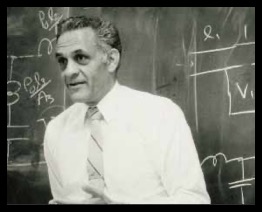
The remainder of this post is from MIT’s obituary for him:
Dr. Bose received his bachelor’s degree, master’s degree and doctorate from MIT, all in electrical engineering. He was asked to join the faculty in 1956, and he accepted with the intention of teaching for no more than two years. He continued as a member of the MIT faculty until 2001.
During his long tenure at MIT, Dr. Bose made his mark both in research and in teaching. In 1956, he started a research program in physical acoustics and psychoacoustics: This led to his development of many patents in acoustics, electronics, nonlinear systems and communication theory.
Throughout his career, he was cited for excellent teaching. In a 1969 letter to the faculty, then-dean of the School of Engineering R. L. Bisplinghoff wrote, “Dr. Bose is known and respected as one of M.I.T.’s great teachers and for his imaginative and forceful research in the areas of acoustics, loudspeaker design, two-state amplifier-modulators, and nonlinear systems.”
Paul Penfield Jr., professor emeritus of electrical engineering, was a colleague of Dr. Bose, and he recalls what made Dr. Bose different. “Amar was personally creative,” he said, “but unlike so many other creative people, he was also introspective. He could understand and explain his own thinking processes and offer them as guides to others. I’ve seen him do this for several engineering and management problems. At some deep level, that is what teaching is really all about. Perhaps that helps explain why he was such a beloved teacher.”
Dr. Bose received the Baker Teaching Award in 1963-64; he would receive further awards in later years. In 1989, the Bose Award for Excellence in Teaching was established by the School of Engineering to recognize outstanding contributions to undergraduate education by members of its faculty. The award was established in order to serve as a tribute to the quality of Dr. Bose’s teaching; it is the School’s highest award for teaching. In 1995, the School established another teaching award, the Junior Bose Award: recipients are chosen from among School of Engineering faculty members who are being proposed for promotion to associate professor without tenure.
“Amar Bose was an exceptional human being and an extraordinarily gifted leader,” MIT President L. Rafael Reif said. “He made quality mentoring and a joyful pursuit of excellence, ideas and possibilities the hallmark of his career in teaching, research and business. I learned from him, and was inspired by him, every single time I met with him. Over the years, I have seen the tremendous impact he has had on the lives of many students and fellow faculty at MIT. This proud MIT graduate, professor and innovator was a true giant who over decades enriched the Institute he loved with his energy, dedication, motivation and wisdom. I have never known anyone like him. I will miss him. MIT will miss him. The world will miss him.”
In 1964, Dr. Bose started Bose Corporation based on research he conducted at MIT. From its inception, the company has remained privately owned, with a focus on long-term research.
“Dr. Bose founded Bose Corporation almost 50 years ago with a set of guiding principles centered on research and innovation. That focus has never changed, and never will,” said Bob Maresca, president of Bose Corporation. “Bose Corporation will remain privately held, and stay true to Dr. Bose’s ideals. We are as committed to this as he was to us. Today and every day going forward, our hearts are with Dr. Bose; and we will do everything we can to make him proud of the company he built.”
In 2011, to fulfill his lifelong dream to support MIT education, Dr. Bose gave to MIT the majority of the stock of Bose Corporation in the form of nonvoting shares. Under the terms of the gift, dividends from those shares will be used by MIT to sustain and advance MIT’s education and research mission. MIT cannot sell its Bose shares, and does not participate in the management or governance of the company.
In expressing appreciation to Dr. Bose on the occasion of the gift, MIT’s then-president, Susan Hockfield, said of him, “His insatiable curiosity propelled remarkable research, both at MIT and within the company he founded. Dr. Bose has always been more concerned about the next two decades than about the next two quarters.”
“Amar Bose was a legend at MIT,” said MIT Chancellor Eric Grimson, who served as a faculty colleague of Dr. Bose in the Department of Electrical Engineering and Computer Science. “He was an incredible teacher, an inspiring mentor, a deep and insightful researcher. He has influenced multiple generations of students, both directly through the classroom and laboratory, and through the many students he influenced who have themselves pursued careers as faculty, propagating Professor Bose’s approach to mentorship and teaching.”
Dr. Bose was given many awards and honors during his lifetime. He was a Fulbright Postdoctoral Scholar, an elected member of the National Academy of Engineering and of the American Academy of Arts and Sciences, and a fellow of the Institute of Electrical and Electronics Engineers.
Vanu G. Bose ’87, SM ’94, PhD ’99, son of Dr. Bose, said, “Personally, my single greatest educational experience at MIT was being a teaching assistant for my father in his acoustics course (6.312). While my father is well known for his success as an inventor and businessman, he was first and foremost a teacher. I could not begin to count the number of people I’ve met who’ve told me that my father was the best professor they ever had and how taking 6.01 from him changed their life.
“My father’s 66-year relationship with MIT was an integral part of his life. He would often talk about his mentors, professors Ernst Guillemin, Norbert Wiener, Y. W. Lee and Jerome Wiesner, as having played critical roles in shaping his life and work. It was because of everything that MIT did for him that my father was so pleased to be able to give back to MIT through his gift.”
=====
Another tribute to Bose from MIT site.
FCC's Secret Store Room of Petitions "in Limbo"
First Amendment
Congress shall make no law respecting an establishment of religion, or prohibiting the free exercise thereof; or abridging the freedom of speech, or of the press; or the right of the people peaceably to assemble, and to petition the Government for a redress of grievances.
5 USC 552(e)
Each agency shall give an interested person the right to petition for the issuance, amendment, or repeal of a rule.

Now much to our amazement we discovered that petitions “in limbo” - those that have neither been announced for public comment nor dismissed - are not hiding in a black hole awaiting a multiyear determination of whether public moments should be requested or whether they should be dismissed. No, they are “hidden in plain sight” in an “undocumented feature” of ECFS!
§ 1.403 Notice and availability.
All petitions for rule making (other than petitions to amend the FM, Television, and Air-Ground Tables of Assignments) meeting the requirements of § 1.401 will be given a file number and, promptly thereafter, a “Public Notice” will be issued (by means of a Commission release entitled “Petitions for Rule Making Filed”) as to the petition, file number, nature of the proposal, and date of filing, Petitions for rule making are available at the Commission's Reference Information Center, 445 12th Street, SW, Washington, DC and may also be available electronically over the Internet at http://www.fcc.gov/.
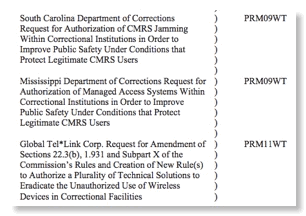
The poor NPRM author who probably did not know why these petitions were given this odd treatment just filed in the blank with the only number he/she could find: an undocumented feature of ECFS used to store petition in limbo! As the NPRM went through the review and adoption process no one notice they were compromising one of the FCC’s favorite administrative tricks to avoid dealing with awkward issues.
So, SpectrumTalk readers here is the trick for finding these hidden petitions. Go to ECFS and type into the box labeled “Proceeding Number:?” a 7 character string in the following format:
- First 3 characters: PRM
- Characters 4-5: last 2 digits of year
- Characters 6-7: 2 letter code for FCC bureau/office e.g. ET, WT
This explains the mysterious PRM09WT shown in the NPRM. That page has petitions filed in 2009 and assigned to the Wireless Telecommunications Bureau.
(Remember that ECFS defaults to documents filed in the past year so if you want older documents you must enter an earlier date in the “Date Search” input area.)
Several questions remain:
- Do petition leave this address once they get an RM number or are dismissed?
- Where do petitions for a declaratory ruling go?
(By contrast petitions for reconsideration are handled by CGB and go on public notice promptly.)
Based on this discovery some voyeuristic wandering through ECFS discovered these pending petitions that we will scoop our competition on:
- Petition from Mimosa Networks filed on May 1, 2013 “ for the purpose of making spectrum in the 10.0-10.5 GHz band available for wireless broadband services.”
- Petition from Fixed Wireless Communications Coalition filed on May 9, 2012 and amended on February 11, 2013 “to restart the Commission's pending proceeding to establish service rules for Fixed Service operations at 41-42.5 GHz (42 GHz band)”
- Petition from James Edwin Whedbee to”amend Part 2 of the rules and regulations to liberalize equipment use by licensees and permittees.”
- Petition from Ben Bartlett for MBAN Spectrum Allocation in TV White Space
- Petition from Boulder Regional Emergency Telephone Service Authority for “adopt rules requiring wireless providers provide electronic data portals through which Public Safety Answering Points can expeditiously retrieve system and caller information related to 9-1-1 and Emergency Notification Services.�”
- Petition from Globalstar, Inc. to “Reform the Commission's Regulatory Framework for Terrestrial Use of the Big LEO MSS Band”
- Petition from Consumer Watchdog “ to Require Mobile Broadband Carriers to Disclose Network Performance”
- Petition from National Regional Planning Council “to create two new public safety specific Radio Service Codes designating conventional and trunked operation in the post re-banded 800 MHz band for spectrum managed by regional planning committees at the local level from 806-851/809-854 MHz.
- Petition from The Society of Broadcast Engineers “to convert the MediaBureau's Consolidated Data Base System (CDBS) to North American Datum 1983 (NAD83) geographic coordinates”
So a question for the incoming Chairman: Does he intend to bring FCC into compliance with the existing requirement of § 1.403 for a prompt public notice announcing petitions for rulemaking? Or do we have to continue snooping around the FCC website to find out what is hidden in the corners?
Panasonic "Smart" TV Threatens Japanese Broadcasters:
Imagine How NAB Feels?
Panasonic says Japanese TV stations are refusing to air commercials for its new “smart” television, apparently because they feel threatened by its combined TV-Internet function.
Private broadcasters, in a rare case of turning down a major advertiser, have said they will not show commercials for the product, claiming the split screen simultaneously showing broadcast content and Web pages may confuse viewers, according to reports.
“IPTV, or smart television, is a new area of service, and we are in talks to create new rules for broadcasting,” Panasonic said Monday in a statement. “We refrain from making further comments.”
As TV viewership declines and a growing number of younger “zero TV” households don’t even have a TV, the US broadcast establishment must not be thrilled about TV sets that blur the line between broadcast video and IPTV. Would US broadcasters go as far as their Japanese counterparts did and refuse the ads? Would FCC permit such action?
It is a brave new world for broadcasters who don’t sell out to the incentive auction and take their money and run. Soon such TVs will come to the US in quantity.
House Commerce Committee Hearing July 11 on “Improving FCC Process”
1. Stuart M. Benjamin, Douglas B. Maggs Chair in Law and Associate Dean for Research, Duke Law
2. Larry Downes, Internet industry analyst and author, including The FCC's Unstructured Role in Transaction Reviews
3. Robert M. McDowell, former FCC Commissioner and Visiting Fellow, Hudson Institute
4. Randolph J. May, President, Free State Foundation
5. Richard J. Pierce Jr., Lyle T. Alverson Professor of Law, George Washington University Law School
6. James Bradford Ramsay, General Counsel, National Association of Regulatory Utility Commissioners
The subcommittee plans to reintroduce two bills that passed the House last Congress: H.R. 3309, the Federal Communications Commission Process Reform Act, and H.R. 3310, the Federal Communications Commission Consolidated Reporting Act. These bills aim to minimize the potential for procedural failings and abuse, and to improve agency transparency, efficiency, and accountability. The hearing will focus on discussion drafts of the two bills in anticipation of reintroduction.
The Federal Communications Process Reform Act passed the House in March 2012 by a 247-174 vote. To avoid micromanaging the agency, many of the provisions simply require the Commission to set its own process rules and then live by them. Among other things, the bill asks the FCC to examine the state of technology and the marketplace and conduct cost-benefit analyses before regulating; to publish the actual text of proposed rules; to afford commissioners, parties, and the public an adequate opportunity to review proposals; to publish its decisions promptly; and to evaluate whether adopted rules are meeting their purpose. It asks the FCC to create “shot clocks” so parties and the public have a sense of when issues will be resolved. To minimize the potential for abuse of transaction reviews, the bill would require any conditions to be narrowly tailored to transaction-specific harms and otherwise within the agency’s jurisdiction. To facilitate negotiation, the bill would reform the “Sunshine Act” to allow three or more commissioners to gather on a bipartisan basis.
(The above summary prepared by the subcommittee staff omits another change that modifies the Government in Sunshine Act and allows nonpublic meetings of commissioners. As this blog has previously pointed out, some closed meetings are permitted under the present law but there have only been 2 closed meeting in the past 16 years. This implies that there is a deeper problem than the Government in Sunshine Act that is not being addressed.)
The Federal Communications Consolidated Reporting Act passed the House in May 2012 on a voice vote. It seeks to relieve burdens on the agency and make reports more meaningful. By eliminating outdated studies and consolidating the ones that remain into a biennial release, the Commission will be more efficient and can provide more useful information. The draft also proposes a “State of the Industry” report, focused on the challenges and opportunities in the marketplace as well as the chairperson’s plan of action.
A subcommittee staff memo gives a detailed discussion of the proposed changes. Here is a link given for the video.
Where Does The Radio Spectrum End?
The article start off with
At the upper end of the spectrum ITU gives 3000 GHz or 3 THz as the upper limit of its jurisdiction. This is the region of infrared which is normally described by wave-length not the equivalent frequency, so for reference 3 THz is equivalent to 100 μm. While ITU gives a numeric limit for the upper limit of radio spectrum, there is some disagreement in the infrared/optics community of the lower limit of infrared technology with various sources giving numbers in the range of 1–3 THz.
For many purposes the difference between RF and infrared is the type of technology used and there is a growing convergence as many recognize that there is a transition zone where technology from both disciplines can be used together. Thus RF technology has be classically characterized by components such as mixers and antennas and infrared technology by lenses and diffraction gratings and new innovative systems use components from both traditions.
The full text of the article is available to SpectrumTalk readers here.
IEEE-USA Petition to FCC on Speeding >95 GHz Deliberations Under Terms of 47 USC 157
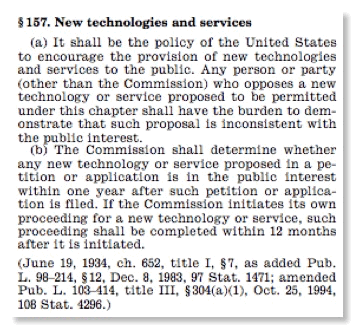
Section 7 of the Communications Act, shown above, was passed by Congress in 1983 and signed by President Reagan. It was then ignored in a bipartisan way by all FCC chairmen and virtually all commissioners for nearly 30 years. As reported here almost a year ago, it was “rediscovered” by Comm. Ajit Pai and was the focus of a speech he gave at Carnegie Mellon University on July 18, 2012.
On July 1, IEEE-USA, the US arm of the multinational engineering society filed at FCC a petition to ask to a declaratory ruling by the Commission that technology above 95 GHz presumptively qualifies at new technology under Section 7. Why 95 GHz? That is the upper limit for both licensed radio systems and unlicensed use under present rules.
(Part 18 ISM equipment may operate at 2 narrow bands above 95 GHz and Amateur Radio Service licensees have access to 3 bands above 95 GHz as well as “above 275 GHz”. Neither of these exceptions will stimulate a market for commercial products.)
The IEEE-USA petition seeks to have FCC presumptively declare that technology above 95 GHz is “new technology” in the context of Section 7 and thus entitled to the “burden” test if Section 7(a) and the timeliness requirement of Section 7(b).
mmW antennas & a dime

But the real issue here is uncertainty about FCC policy and the resulting regulatory risk that discourages capital formation for innovative technology. In the past few months I asked 5 prominent lawyers who specialize in spectrum issues how long it would take to a developer of >95 GHz technology to get FCC rules in place for normal sale and licensing (or unlicensed use) of the technology. One said 2 years, the other 4 said 4-5 years based on recent FCC performance in proceedings like UWB, AWS-3, and LightSquared.
Venture capitalists and “angels” have many people seeking funding for innovative technologies, most of whom are not subject to the regulatory uncertainties of FCC wireless technology regulation. These other technologies are therefore much more attractive to such capital than innovative wireless technology.
Furthermore, our major international competitor countries have a “state capitalism” viewpoint of wireless technology and regulation where the government “encourages” investment in chosen technologies, in some cases with government-controlled funding and coordinates spectrum policy to match the investments.
That is not the US system and probably should not be the US system. But it puts our technology developers, as well as our international competitiveness, at a real disadvantage if FCC does not consider such innovative technology in a timely way.
Hopefully FCC will request public comment on this petition quickly.
vox populi, vox dei



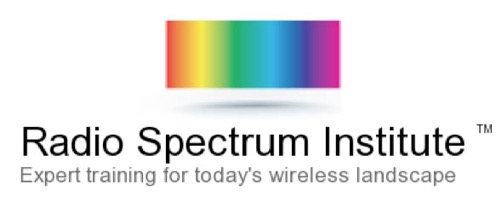


![Validate my RSS feed [Valid RSS]](valid-rss-rogers.png)

